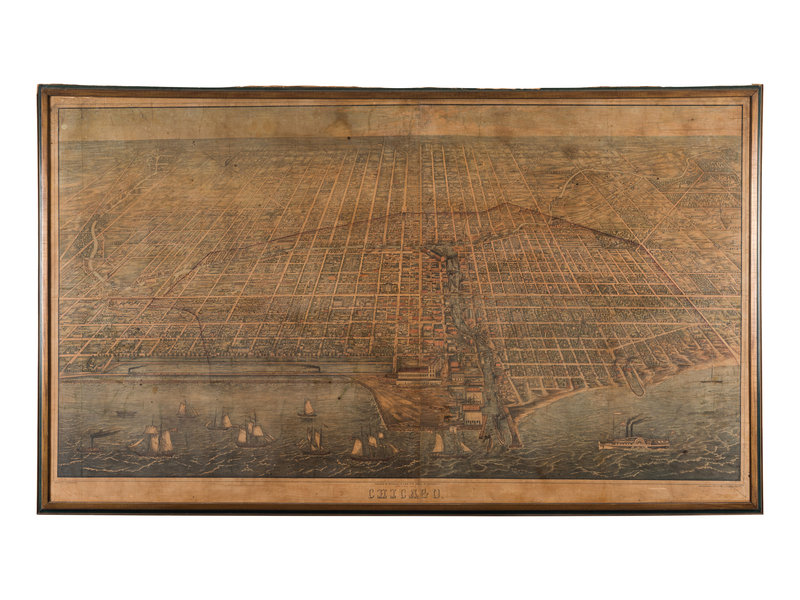Lot 704
PALMATARY, J[ames] T. Chicago. Cihcago [sic]: Braunhold & Sonne [now Charles Sonne], [1857]. FIRST EDITION OF THIS RARE AND IMPORTANT MAP. Palmatary’s bird's-eye view of Chicago. VERY SCARCE.
Sale 1097 - Fine Printed Books & Manuscripts, Including Americana
Lots 1-410
Nov 8, 2022
9:00AM CT
Lots 411-717
Nov 9, 2022
9:00AM CT
Live / Chicago
Own a similar item?
Estimate
$50,000 -
70,000
Price Realized
$56,250
Sold prices are inclusive of Buyer’s Premium
Lot Description
PALMATARY, J[ames] T. Chicago. Cihcago [sic]: Braunhold & Sonne [now Charles Sonne], [1857].
Engraved bird's-eye view of Chicago with contemporary hand-coloring on 4 sheets, image 1213 x 2107 mm. (Laid down on a backing board, some overall browning, some cracking and tiny holes with occasional losses, some spotting.) Framed.
FIRST EDITION OF THIS RARE AND IMPORTANT MAP.
Palmatary drew his bird's-eye view of Chicago just one year after the Illinois Central Railroad was completed; when it opened in 1856, the Illinois Central was the longest railroad in the world, running 705 miles from Cairo, Illinois to Chicago, and it features prominently in Palmatary's view in the lower left, with tracks on trestles protected by breakwaters and dikes over a strip of land several hundred feet out in Lake Michigan. The Illinois Central originally intended to enter Chicago from the south, and requested permission to lay track along the lakefront to reach the city's inner harbor. They were not granted permission, however, because the section of lakefront (also visible lower left) had been designated for public use in 1836 by the Illinois and Michigan Canal Commission (marked "Public Ground-A Common to remain Forever Open, Clear, Free of Any Buildings, or Other Obstruction Whatever" on a real estate map from 1836). After months of fighting, the City Council granted the Illinois Central the land in Lake Michigan, which led to the northern terminus for the railroad in the old Fort Dearborn reservation.
Visible in the lower right is an area called "The Sands," near present-day Streeterville, notorious in its time for having a high concentration of brothels, gambling dens, saloons and inexpensive motels; the Sands became a point of refuge for Chicagoans in 1871 during the Great Chicago Fire. The lower margin includes a legend of notable places in the city, including Richmond House, the U.S. Marine Hospital, Grain and Freight Houses, the McCormick Reaper Factory, the "Illi. & Diversy" Brewery, and the Chicago Water Works. The view includes street names, homes, churches, and points of industrial interest, and was lithographed by Christian Inger, or Herline & Hensel in Philadelphia. Along the north and east portions of Wolf Point, three buildings have been drawn in by hand; these hand-drawn buildings are present in all copies we have examined.
VERY SCARCE: We trace only one other copy of this exceedingly rare map at auction in the last 100 years, sold in these rooms 13 September 2017; it is one of five known copies, and is one of only two copies in private hands, with copies being held by the Newberry Library, the Chicago History Museum, and the Library of Congress. Robert Holland, Chicago in Maps 1612-2002, (2005), pp.80-83; Robert Karrow, Checklist of Printed Maps of the Middle West to 1900, (1981), 4 0357; John R. Hubert and Patrick E. Dempsey, Panoramic Maps of Cities in the United States and Canada, (1984), p.38, Illinois No.146; Reps 800.
Condition Report
Contact Information
Auction Specialist

